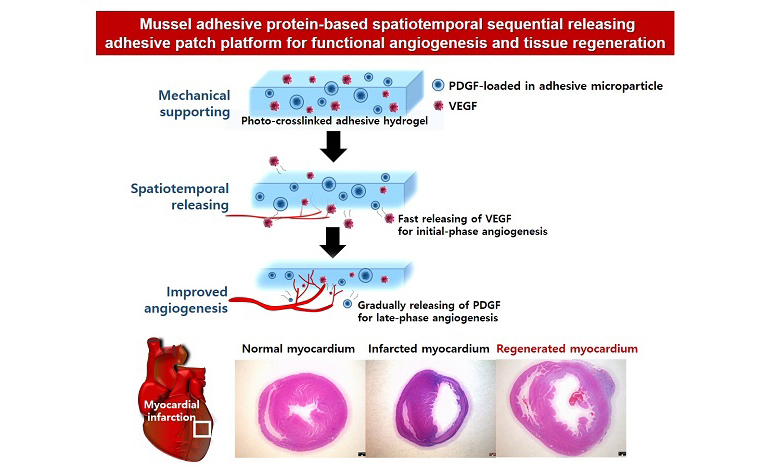Researchers at the Pohang University of Science & Technology (POSTECH) in South Korea have developed a hydrogel patch system that allows for sophisticated sequential release of growth factors that stimulate angiogenesis. The sequential cascade of growth factors mimics the natural process in the body and the researchers hope that the technology could provide regenerative efficacy in ischemic disease, such as myocardial infarction.

Ischemic disease poses a huge chronic burden on patients and healthcare providers. Treatments that can help to restore blood flow to ischemic tissue represent a promising way to help reduce or reverse the damage caused by ischemic disease. Therefore, researchers are working on a variety of clever ways to achieve this.
However, blood vessel growth, known as angiogenesis, is somewhat complex, involving different growth factors that are active at different stages of the process. Simply delivering one growth factor, or several all at once, is unlikely to result in functional and mature blood vessels. Therefore, delivering different growth factors to the affected area at different times is a more promising approach.
This latest technology developed at POSTECH rises to this challenge. It involves microparticles made using mussel adhesive protein and hyaluronic acid. The researchers loaded the particles with platelet-derived growth factor (PDGF), which is involved in late-stage angiogenesis.
The team then suspended the particles in a viscous and adhesive hydrogel, also containing mussel adhesive protein, and blended endothelial growth factor (VEGF) into the gel, an early stage angiogenic growth factor. The finished gel allows for sequential release of VEGF and PDGF in a way that provides enhanced angiogenic efficacy when it is administered as a patch on the surface of ischemic tissues or as a bioglue. The gel releases VEGF first, to kick start angiogenesis, and then PDGF later to help the growing vessels to mature.
So far, the POSTECH researchers have tested the gel in rat models of myocardial infarction and skin damage. They observed that it could stimulate the growth of functional vasculature and had regenerative efficacy in ischemic tissue.
“We have developed a new platform that can efficiently deliver angiogenic factors spatiotemporally by using the formulation property of mussel adhesive protein, an original biomaterial,” said Hyung Joon Cha, a researcher involved in the study, via a press release. “This platform can play a key role in the neovascularization treatment market as it uses biocompatible biomaterials that are harmless to the human body.”
Study in journal Biomaterials: Adhesive protein-based angiogenesis-mimicking spatiotemporal sequential release of angiogenic factors for functional regenerative medicine
Via: POSTECH
